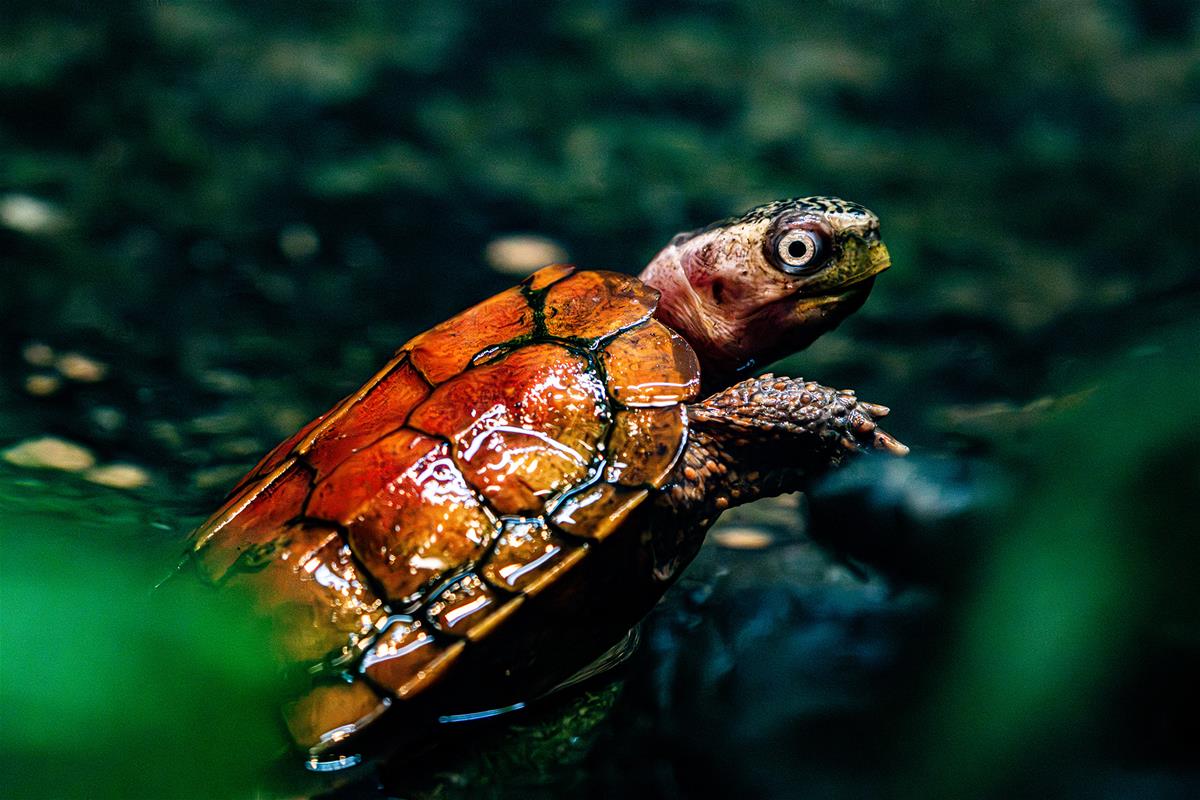Black-breasted leaf turtle
Geoemyda spengleri
Order: Chelonia
Family: Geomydidae
Genus: Geoemyda
The black- breasted leaf turtle has a dark, unpatterned plastron with a yellow lateral border. Three keels run from head to tail on the carapace, which is flattened and serrated at the front and back. These turtles’ feet are partially webbed and their large eyes are unusually protruding, giving an alert and curious expression. Turtles do not have teeth, instead their mouths have a hard, sharpened edge that they use to bite with, similar to a bird’s beak. This turtle is one of the smallest in the world. There is considerable variation in the colour of the carapace (top shell), from orange-yellow or tan, to chestnut or mahogany brown, to olive colour. The plastron (lower shell) is almost completely black with a yellow border. The head is olive or brown and the body is brown or greyish-brown with some orange to red-orange speckling on the front legs and neck. There is a white ring around the eyes; yellowish-brown in females and bluish-tinted in the male. A yellow head stripe runs down the neck of the females but is less prominent on the males. Sexual dimorphism is further exhibited in the tail where the tail of the female is shorter and thinner than the male. Further, her cloaca is situated at the base of the tail, whereas, in the male it is near the tip.
Conservation Status: IUCN
Distribution
Hainan Island, southern China, Vietnam through Sumatra and Borneo.
Habitat
These turtles are found in montane forests, along mountain streams at altitudes of 500 to 1,000 m. They are primarily terrestrial, spending most of their time in leaf litter on the forest floor and in freshwater streams.
Diet
Omnivorous: fruits, vegetables, greens, insects, worms, and slugs.
Reproduction
The colouration of the carapace and the speckling on adult males’ front legs and neck becomes more intense during the breeding season. Mates are frequently found together which is thought to be either courting behaviour or the male chasing the female until he can initiate copulation. Females lay clutches of one to two eggs, which incubate for 40 to 65 days. The clutch is positively related to body size and the eggs are elongated.
Adaptation
These turtles are admirably adapted to their dimly-lit environment beginning with a notched shell which resembles a dead leaf. Further, their large prominent eyes probably allow for effective vision in their sub leaf-litter habitat where they are animated and agile. Intensively active during mating, they require good eye-sight and clear male-female recognition. This could be aided by the sexual dimorphic colouring of the iris and the distinctive but differently coloured neck stripes between males and females. The partially webbed feet suit a life style which is mainly terrestrial but also aquatic.
Threats to Survival
Overexploitation by humans from the wild for the food, medicine, and the pet trade. These turtles’ unique facial expression and small size make them particularly attractive within the pet trade. However, these turtles are also very sensitive to their environment and mortality rates of this species in captivity are very high. Turtles that survive a shipment are frequently malnourished or develop pneumonia, mouth sores or other illnesses, and almost all will have parasites, from which many die. Furthermore, the turtles’ are facing habitat loss due to rapid deforestation in southeast Asia.















